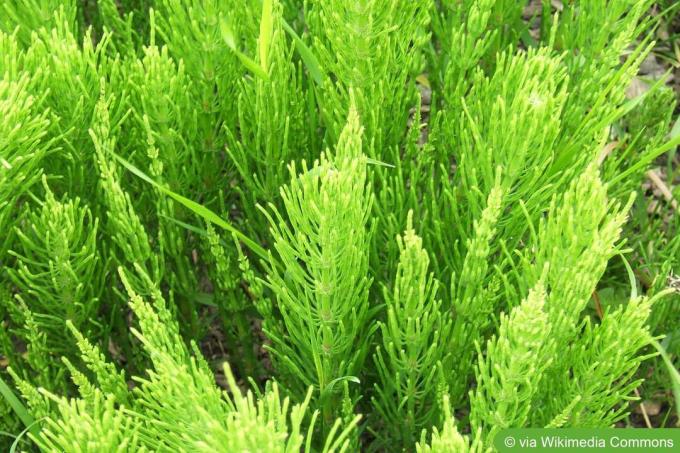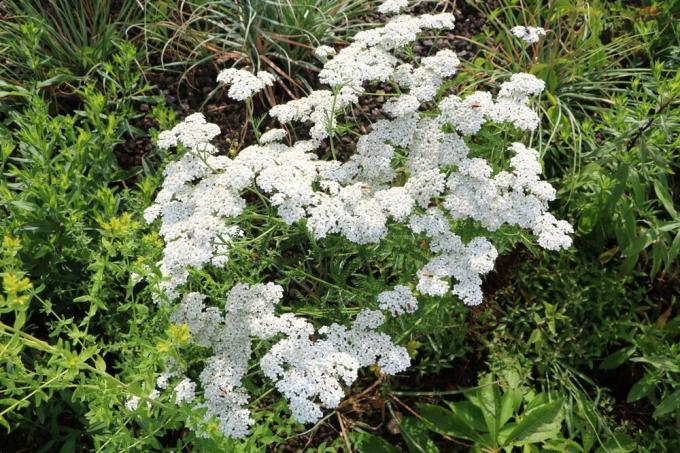

Table of contents
- Why is combat so delicate?
- Destruction strategies in the lawn
- mowing
- scarify
- liming
- Control in the bed
- digging up/digging
- changing cultural conditions
- stop photosynthesis
- Home remedies work selectively
- Herbicides: Gierschfrei by Neudorff
- Conclusion
Basically, field horsetail deserves a high degree of respect in view of its multifaceted advantages. However, if the prehistoric rhizome geophyte has chosen your garden as its domicile, the joy about it is limited. The richly branched green plant sets out to conquer your green oasis with vehemence. Experience has shown that combating it is extremely difficult, exhausting and time-consuming. However, the endeavor is not entirely hopeless. Read here how to destroy field horsetail in the lawn and garden.
Why is combat so delicate?
Field horsetail has inhabited the earth for more than 370 million years. This gave the fern-like plant enough time to develop the optimal survival strategy. This consists of a generative and vegetative propagation that can hardly be surpassed in terms of efficiency. Distantly related to ferns, horsetail produces shoots densely covered with brown spores between March and early May. With a height of 5 to 20 cm, these remain comparatively small and die off after dusting. Previously, the microscopically small spores had spread by the millions in the bed to allow a new generation to thrive. From the beginning/middle of May, the plant then puts out its deciduous main shoots, densely covered with whorls of needle leaves.
Not enough, horsetail also uses vegetative propagation by means of stolons. The strong rhizomes not only drive up to 2 meters deep into the ground, but also spread out horizontally. Numerous young plants then sprout from these root runners. On the other hand, if you want to proceed with classic weeding, you are in a lost position. As long as even a tiny rhizome segment remains in the ground, horsetail will happily sprout again.
Destruction strategies in the lawn
If field box stalks take over the lawn, the chances of complete destruction are good. While in ornamental and useful beds, there are a number of things to consider when controlling neighboring plants, only the noble grasses should be considered here - and these are tough in the Take. The following destruction measures can be used individually or better in combination.
mowing
The growth of the spore-bearing shoots begins parallel to the beginning of this year's lawn season. Regular mowing from March/April to a depth of 4-5 cm effectively prevents the generative propagation of field horsetail. In the long run, the uninvited plant is so weakened that it retreats.
scarify
One of the fundamental lawn care measures in spring is scarifying. All weeds such as moss, clover and even horsetail are combed out with a special device. Although the deep-reaching rhizomes are not fully covered, this approach contributes - in combination with weekly mowing - for effective control of field horsetail in the lawn at. How to do it right:
- On a dry, overcast day, mow the lawn as low as possible
- Then work the green area with the scarifier in a chessboard pattern
- Sweep up and discard all combed plant material
- After 8-10 days of regeneration, fertilize and water the lawn
In this case, do not dispose of the combed weeds in the compost. Since there are segments of field horsetail in it, the weeds will find their way back into the garden from the compost heap. Small amounts end up in the household waste, larger amounts go into the city
composting facility.
liming
Field horsetail prefers soils with an acidic pH between 4 and 5, while turf achieves its optimum at a pH between 6 and 7. Use an uncomplicated test set from the hardware store to check the current soil acidity of your troubled green space. In addition, a high occurrence of moss signals an acidic pH value, so that a well-dosed liming kills two birds with one stone. They deprive both lawn weeds of their livelihood.
Tip:
If a lawn is covered with clover, this deficiency indicates that the pH value is too high. In this case, the application of lime does not have an effective control effect on horsetail, but only exacerbates the clover problem.
Control in the bed
A first step towards destroying field horsetail in the bed tends in a similar direction as combating it in the lawn. Consistently removing the shoots with the brownish sporangia between March and May at least keeps further spread in check.
Tip:
The distribution of lime to destroy horsetail to raise the pH value only makes sense if the neighboring plants are lime-tolerant. Ornamental and useful plants, however, prefer a slightly acidic to neutral soil.
digging up/digging
If a bed or entire area has fallen prey to the horsetail invasion, digging promises or the more intensive digging a lasting destruction, provided that it is still young plants acts. If the rhizomes have not penetrated more than 2 spades deep into the ground, proceed as follows:
- Cut or mow the horsetail as low as possible with a scythe
- Dig a trench 2 spade blades deep, across the working area
- Clean the soil from the first furrow using a throw-through sieve and pile it up on the side
- Throw the spoil from the second trench through the screen and shovel it into the first furrow
Follow this pattern until the last furrow, which is filled with the excavation from the first trench. It is important to note that the sieved horsetail parts are not disposed of in the compost.
changing cultural conditions
Since field horsetail prefers lean, wet and cold soil in addition to an acidic pH value, experienced hobby gardeners make their uninvited guests as uncomfortable as possible. As far as the neighboring plants tolerate it, the conditions in the garden are changed to such an extent that horsetail grows little or not at all. The following procedures have proven themselves in practice:
- Fertilize regularly with mature compost, horn shavings, guano, dung or bark humus
- Consistently mulch with nutrient-rich materials such as tomato shoots, stable manure or horse droppings
- Prevent waterlogging by regularly raking and incorporating sand, fine gravel, compost or expanded clay
Since horsetail is one of the sun worshipers, it does not like partially shaded or shady locations. The planting plan for endangered or already infested locations in the garden should therefore include deciduous trees or other towering plants that overshadow field horsetail.
stop photosynthesis
An equally drastic and effective method of destroying horsetail in the garden prevents the vital photosynthesis. In concrete terms, this means that the plant is cut off from the sunlight it needs for life over a longer period of time. Although this process takes several months, it results in the permanent destruction of horsetail. How to proceed:
- Cut or mow the infested bed deeply
- Spread black, completely opaque foil
- Lay individual strips of foil with an overlap of at least 10-15 cm
- Cover the edges and corners with stones or fix them with ground anchors
So that the underground rhizomes cannot find a way out under the foil cover, it should protrude at least half a meter over the edge of the bed in order to be fixed there. If even a single ray of light reaches the horsetail, photosynthesis and rampant growth continue unhindered. Expect the first positive results after 6 months.
Tip:
Spread a layer of bark mulch, decorative pine bark or decorative gravel over it so that the black foil cover does not impair the visual appearance of the garden.
Home remedies work selectively
In order to deal with a large-scale infestation of the garden with field horsetail, classic home remedies are in vain. In order to destroy individual plants selectively, reaching into grandmother's box of tricks is at least worth a try. Since horsetail does not tolerate salt, sprinkle the parts of the plant and the root disc with table salt. The traditional combination of salt and vinegar can also be used, as long as the site is not sealed or paved. Boiling water poured on the plant and its rhizomes if it is a young plant has a deeper effect.
Herbicides: Gierschfrei by Neudorff
The tenacity of field horsetail has so far triumphed even over the inventive manufacturers of chemical weed killers. If you ask the database of the Federal Office for Consumer Protection and Food Safety about an approved herbicide, you will get a blank page as an answer. However, since horsetail is one of the dicotyledonous weeds, which also includes ground elder, herbicides designed for it could be successful. With 'Gierschfrei', the Neudorff company offers such a special weed killer. Compo is aiming in a similar direction with the herbicide 'Vorox Gierschfrei'. Since these preparations only develop their effectiveness for one season and come along with considerable impairments of people and nature, their use needs to be carefully considered.
Conclusion
During its evolution of more than 370 million years, field horsetail had enough time to adopt the optimal survival strategy. It is therefore no child's play to bring the vehement urge to spread the lush green plant under control; not to mention a complete expulsion from the garden. Nevertheless, plagued hobby gardeners are not entirely lost. The consequent removal of the spore stands nevertheless weakens the geophyte. In addition, you can achieve acceptable long-term success with measures such as regular liming, digging, trenching, fertilizing and drainage. Covering the bed with black foil has a devastating effect, as photosynthesis comes to a standstill. Classic household remedies, such as salt and vinegar, fall far behind in their effectiveness and only combat horsetail temporarily and selectively. Those who are not afraid to use chemical herbicides are well advised to use Gierschfrei from Neudorff or Compo, which also puts an end to field horsetail, at least for one season.
 garden editorial
garden editorial I write about everything that interests me in my garden.
Learn more about medicinal herbs

Celery, Apium graveolens: 14 tips for growing
Celery is often used as a soup vegetable along with other vegetables and herbs. There are several variants of celery, the cultivation of which hardly differs from each other. You can read here what you need to bear in mind.

What is the effect of yarrow? | 9 areas of application
Yarrow is considered by many to be a weed in the garden, but in herbal medicine positive effects on health are attributed to the plant. But what effect should yarrow have and how can the plant be used?

Gotu Kola, Centella asiatica: Care from A – Z
The plant Centella asiatica, also known as Indian pennyroyal or tiger grass, is considered a so-called superfood and is currently very trendy. In Asia it is used under the name Gotu Kola as a medicinal plant that is said to accelerate wound healing and have an antidepressant effect. The tiger grass requires relatively little care and can basically also be grown successfully in this country.

Make comfrey ointment yourself | Instructions for making leaves
Comfrey is a valuable herb whose healing properties were praised by Paracelsus and Hildegard von Bingen. It can be used to make oils, tinctures and ointments. Both the roots and the leaves are suitable for making an ointment.

Process Comfrey | Dry and apply comfrey root
Comfrey, also known as comfrey or comfrey, is a very old medicinal plant that grows in the garden and outdoors in this country. However, the use of comfrey should always be done with care, because the plant also contains harmful substances.

Identify edible wild herbs: list of 20 herbs
Wild herbs can be found everywhere in nature. We don't have to sow them first. No tedious maintenance either. Just harvest and enjoy. Sometimes it's the leaves, sometimes the blossoms or even the roots that give our dishes a special pep.

